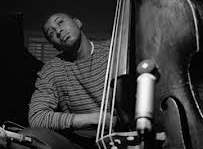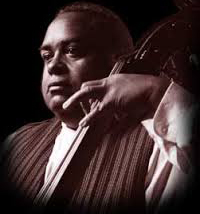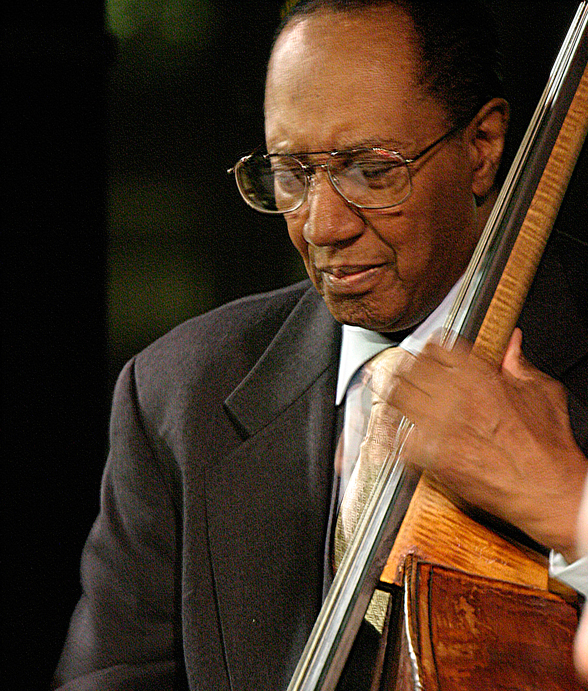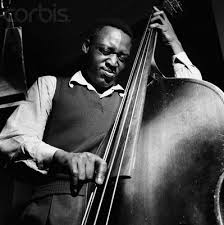Bass Corner / Basic Bass
There are many songs on jazzleadsheets.com that would be helpful for bassists of all levels, but certain parts of the arrangement are a little difficult for less experienced players. In order to make them within everyone's reach, we've created BASIC BASS parts. We've simplified the bass line instead of re-writing it, so the bassist can still practice along with the original recording and lock right into the bassist and the rest of the rhythm section on the track. Even inexperienced bassists can play the charts without losing the integrity of the arrangements.
There's a fundamental reason why the bassist is usually positioned in the middle of the rhythm section, between a pianist (or guitarist) and drummer. The bassist must be the glue that holds the rhythm section together. The bassist's ultimate goal is to make the rhythm section feel good and hold together.
Play our Basic Bass parts along with the original recordings. Playing along "with" great bass artists who are sandwiched between great pianists and drummers will immediately broaden your musical experience. Playing our BASIC BASS editions with the original recordings, while listening carefully to these great artists, making sure you're locked in with them, is extremely valuable experience. Soon you won't be inexperienced any more!
- Blue Spring Shuffle - Kenny Dorham Swing (medium)
- Dig Dis - Hank Mobley Swing (medium)
- Touching Affair - James Williams Even 8ths
- High Modes - Hank Mobley Swing (medium)
- 18th Century Ballroom - Ray Bryant Swing (medium up)

Paul Chambers
Bassist Paul Chambers was a leading rhythmic force in the 1950s and 1960s. He became one of the signature bassists in jazz history. Born in Pittsburgh but raised in Detroit, Chambers initially took up the baritone horn as a child. He followed suit with the tuba and didn't become interested in the string bass until 1949. Listening to Charlie Parker and Bud Powell and studying under a bassist of the Detroit Symphony Orchestra, Chambers began making headway in small bars of Hastings Street area and doing club jobs with Kenny Burrell, Thad Jones and Barry Harris. He did classical work in a group called the Detroit String Band, a rehearsal symphony orchestra. Read more...

Ray Drummond
Ray Drummond is a bass player and educator with a prolific career. He is best known as a sideman and has appeared on over 300 albums, but he has eight albums as a leader under his belt and close to three decades of experience leading combos. Ray's musical life began at age eight when he took up the trumpet, but he switched to bass at 14. He attended Stanford Business School and worked in business while gigging on the side with musicians like Bobby Hutcherson and Tom Harrell. In 1977, he left the corporate world behind and moved to New York, where he worked with the biggest stars on the scene: Betty Carter, the Thad Jones/Mel Lewis Orchestra, Wynton Marsalis, Woody Shaw, Hank Jones, Jon Faddis, Milt Jackson, Johnny Griffin, Kenny Barron, Pharoah Sanders, and George Coleman. Read more...

Jymie Merritt
Hailing from Philadelphia, PA, Jymie Merritt grew up in good company, playing his first professional gigs with John Coltrane, Tadd Dameron, Benny Golson and Philly Joe Jones. Merritt is most known for his work with Art Blakey and the Jazz Messengers from 1957-1962. He also played with musicians such as blues guitarist B.B. King, trumpeter/vocalist Chet Baker, Max Roach, Dizzy Gillespie, and Lee Morgan, and led his band "The Forerunners" for several decades in his hometown of Philadelphia. Read more...

Wilbur Ware
Wilbur Ware's unique approach to the function of the bass in an ensemble has inspired countless musicians to play what they hear, even if it's not the most typical approach. Ware was renowned for his idiosyncratic yet immensely swinging beat that locked down the band rhythmically, as well as his highly creative harmonic sense. Wilbur's ability to play his "own notes," as bassist Ron Carter said, distinguished him from the other practitioners of his instrument. John Coltrane stated in an interview with August Blume, "Wilbur Ware, he's so inventive . . . He doesn't always play the dominant notes . . . He's superimposing things. He's playing around, under and over, so when he comes back you feel everything set in . . . A lot of fun playing that way." Read more...
